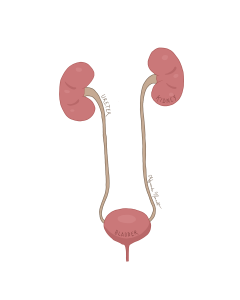65 Ureters, bladder, sphincter and urethra
Where does urine go from the kidneys?
With the kidneys filtering your blood around the clock, urine is constantly being produced, but the body is generally able to control when we store and expel urine thanks to the ureters and bladder.

Figure 123 Frontal view of the kidneys, ureters and bladder
As the kidneys transform filtrate to urine, it flows out of the kidneys to be stored in the bladder via a narrow, muscular tube known as the ureter.
The urinary bladder is a hollow organ located in the pelvic cavity, posterior to the pubic symphysis. Its main function is to hold urine until it is voluntarily released through the urethra. In adults, the bladders can comfortably hold 400-600 mL of urine, though it can stretch to hold a greater volume due to its muscular nature.
When the bladder fills with 400-600 mL of urine, the stretch receptors of the bladder wall are stimulated. These receptors send sensory signals to the spinal cord, which causes the internal urethral sphincter to relax. This sphincter is made of smooth muscle, and so it is controlled by the autonomic nervous system. But don’t worry, you won’t start urinating without your say-so! That’s thanks to the external urethral sphincter, which is composed of striated muscle and is under voluntary control. However, this control does not last forever, so no matter how hard you try to hold it in, micturition (urination) will eventually have to occur.

